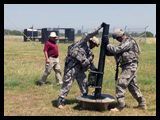
U.S. Army Training and Doctrine Command, or TRADOC, has partnered with USARIEM to conduct the Physical Demands Study. Here Dr. Joseph Seay from USARIEM observes tests that will be used to determine the physical requirements necessary to perform all combat-type jobs, including infantry, armor, artillery and engineering.
|
NATICK, Mass. (Nov. 21, 2013) --The U.S. Army Research Institute of Environmental Medicine is working to objectively determine the physical demands of the military occupational specialties.
U.S. Army Training and Doctrine Command, or TRADOC, has partnered with USARIEM to conduct the Physical Demands Study. The study will be used to determine the physical requirements necessary to perform all combat-type jobs, including infantry, armor, artillery and engineering.
Edward Zambraski, division chief of USARIEM's Military Performance Division, is leading the research teams. This team of USARIEM investigators includes exercise physiologists, biomechanists, a physician assistant, an occupational therapist and psychologists, all of whom will share their skills across disciplines to accomplish this massive research effort.
Zambraski said his team's mission is to produce scientifically validated research that leads to accession standards.
"Ultimately, our goal is to develop a battery of predictive tests that are field expedient to best match an individual's physical capabilities to the demands of specific MOS tasks," Zambraski said. "The key will be to come up with predictive physical performance tests to determine whether an individual, regardless of gender, will be able to physically perform the job in that military occupational specialty."
The project is expected to take three years and will involve hundreds of Soldiers as volunteers.
Marilyn Sharp, the principal investigator for this study, said USARIEM's researchers will independently and scientifically evaluate and validate all data within the study.
"The first thing we did was a job task analysis to determine what the physical demands of the tasks are for each MOS that we studied," Sharp said. "Once those critical physically demanding tasks are identified, such as loading a Howitzer, the next step is to develop accurate task simulations so they resemble the MOS tasks."
Sharp said USARIEM has assisted TRADOC to identify these critical physically demanding MOS specific tasks, and USARIEM is now applying scientific rigor and methodology to record physiological data from Soldiers performing the tasks.
Measurements of heart rate, breathing rate and oxygen consumed (or the energy required during the task) are being made before and during the execution of these physical tasks.
This is all leading to the final phase, which will be to test Soldiers performing the task simulations and predictive tests to determine the relationships between the two sets of tests. A Soldier's performance on these two sets of tests will be used to develop an equation that can predict a Soldier's likelihood of successfully performing the critical tasks in a given MOS.
"This is a science-based approach that determines the key physical tasks required to do a particular job and the tests by which we can measure someone's physical capacity to perform those tasks," said Gen. Robert W. Cone, commanding general of TRADOC. "Our fundamental goal is to place everyone on a path toward a meaningful career based on individual merit, simultaneously ensuring the highest levels of combat effectiveness."
Learn more at Army.mil
|